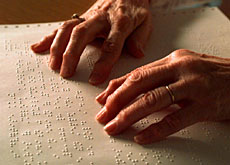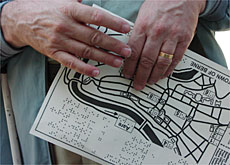Bionic eye offers new window on the world

Retinal diseases afflict millions of people worldwide, and in the worst cases can lead to blindness.
But Swiss researchers are hopeful that a microchip, implanted in the eye, could restore sufferers’ sight by acting as an artificial retina.
“The prospects for such a project have become better as our physiological knowledge and the technical possibilities have converged,” said Philippe Renaud from the Federal Institute of Technology in Lausanne.
Renaud’s laboratory is collaborating with Geneva University Hospital on the project.
A healthy human eye has millions of cells, which convert light into electrical signals. These are then sent along the optic nerve to the brain to be interpreted.
Many people who gradually go blind are suffering from the malfunction or destruction of these photoreceptors or light-sensing cells.
Although these cells at the back of the eye have degenerated, the link back to the brain is often still intact.
Artificial sensor
Researchers believe that an artificial sensor can replace the function of the damaged cells.
The microchips have to be small enough to be implanted in the eye and compatible with the surrounding eye tissue.
The Swiss chip, which is about 1.5 millimetres square, consists of a 14 by 14 array of light sensitive cells. Its thickness is a mere one-50th of a millimetre.
As researchers are able to put more cells onto each chip, the resolution of images should improve further.
Experiments have shown that 100 pixels – the dots of illumination that make up an image – are sufficient to read single letters on a computer screen.
It is generally believed that at least 500 pixels are needed to restore useful vision.
The chip, developed in Switzerland, consists of many layers with different materials including silicon and aluminium.
“Both materials are not stable in the body so we packed up the chip in biocompatible plastic and coated the electrodes with platinum,” said Dominik Ziegler, who worked on the project for his diploma at the Federal Institute of Technology in Lausanne.
Human trials
So far the Swiss teams have carried out implants on rats, and caution that human trials are at least five years away.
The people most likely to benefit are those suffering from retinitis pigmentosa, a rare inherited disease that causes blindness by destroying the retina, and age-related macular degeneration, a condition which causes a deterioration of the central part of the retina in the elderly.
In the United States, sightless patients have already been able to see light and in some cases pick out shapes and recognise faces after having an artificial retina inserted in their eyes.
swissinfo, Vincent Landon
Millions of people worldwide are affected by retinal diseases that lead to loss of vision.
The retina is a thin layer of neural tissue that lines the back wall inside the eye.
Some of these cells receive light while others interpret the information and send messages through the brain to the optic nerve.
In damaged retina, the light receptors stop working, causing blindness.
However the nerves behind the retina, which carry electrical impulses, still function.

In compliance with the JTI standards
More: SWI swissinfo.ch certified by the Journalism Trust Initiative


You can find an overview of ongoing debates with our journalists here . Please join us!
If you want to start a conversation about a topic raised in this article or want to report factual errors, email us at english@swissinfo.ch.